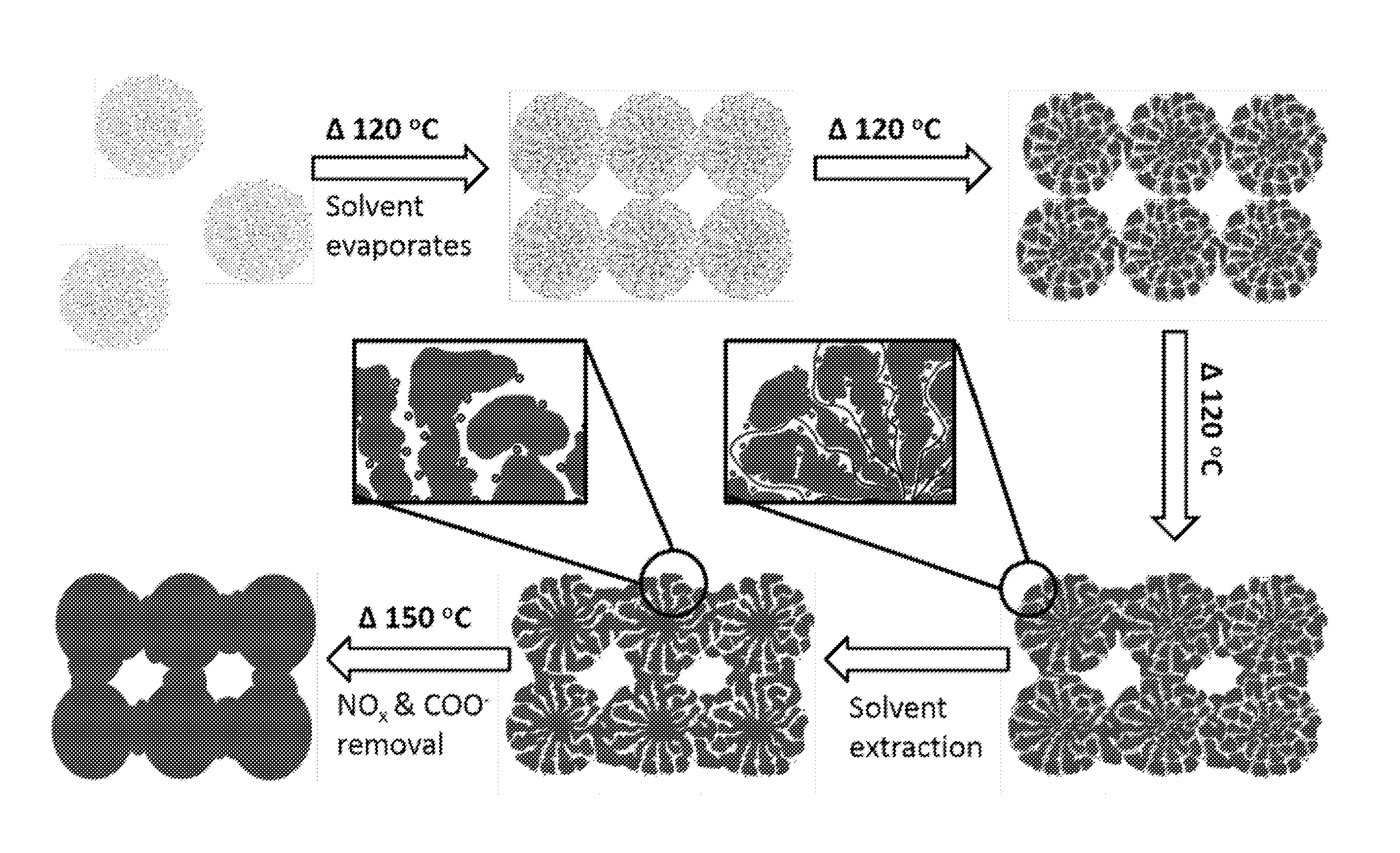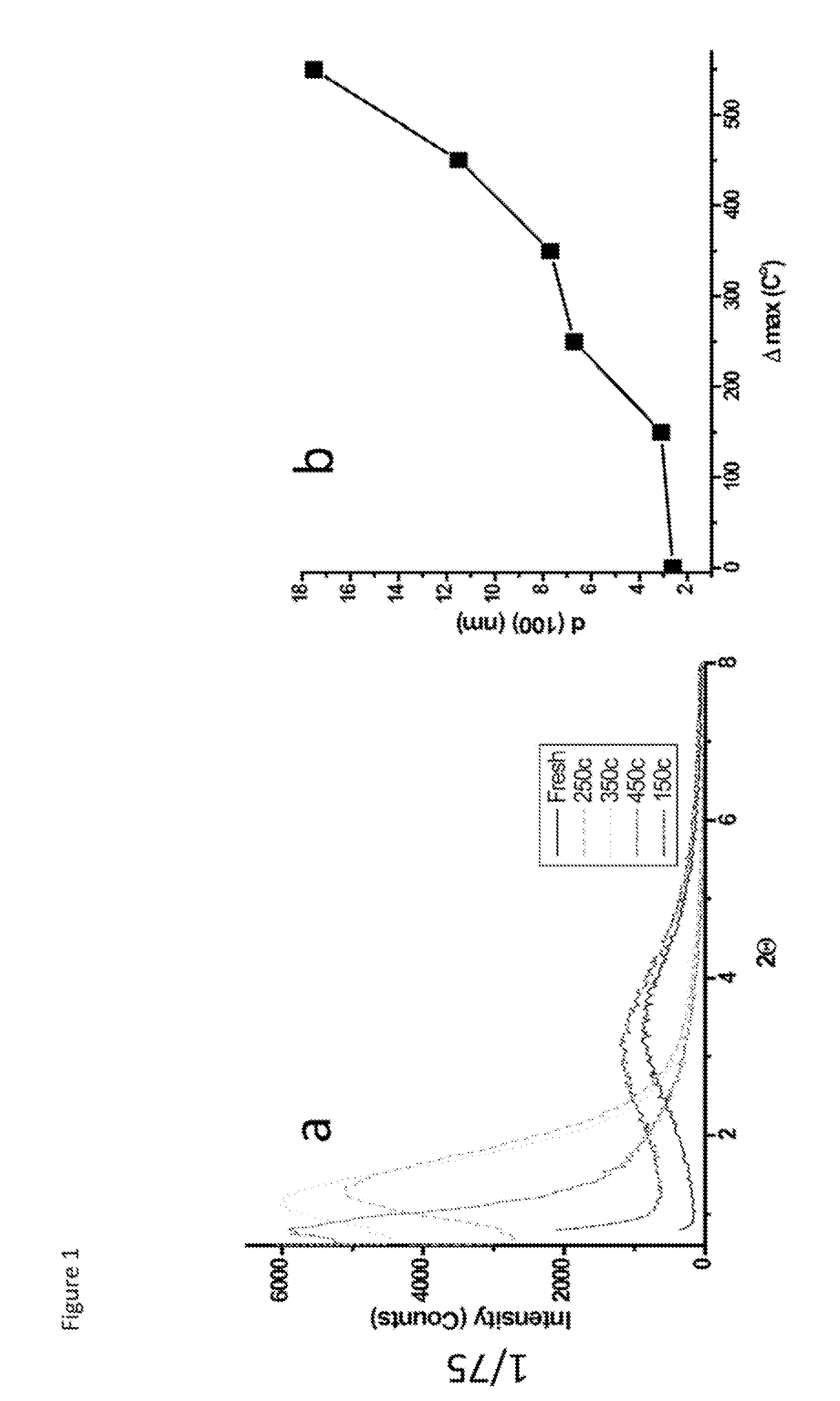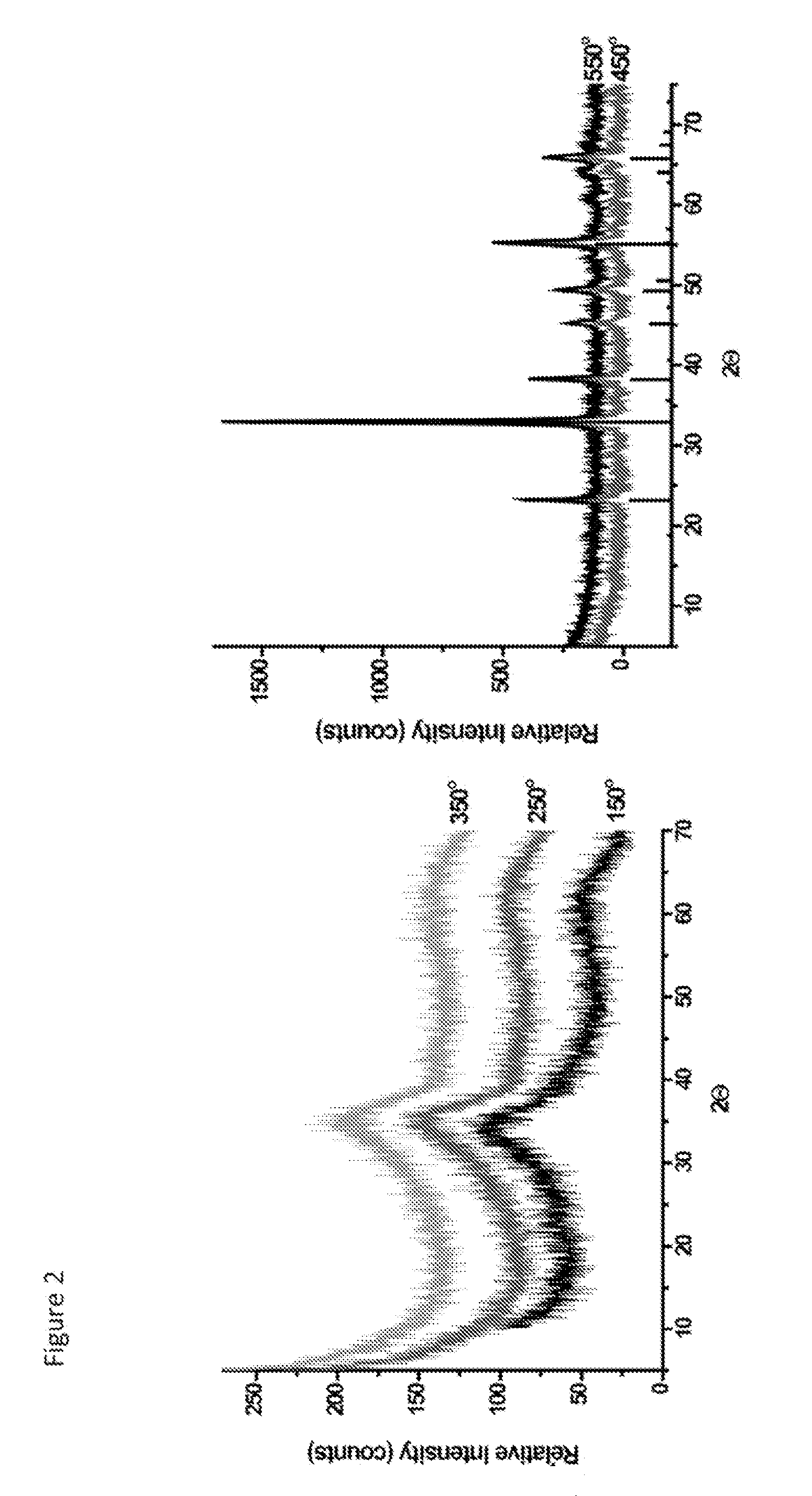Mesoporous metal oxides and processes for preparation thereof
a technology of metal oxides and mesostructures, applied in the direction of aluminium oxides/hydroxides, germanium dioxide, chromium oxides/hydrates, etc., can solve the problems of limited thermal stability and amorphous walls, difficult control of pore size distribution, and difficulty in systematically controlling such pore sizes and uniformity, etc., to achieve stable calcination, preserve porosity and mesostructure
- Summary
- Abstract
- Description
- Claims
- Application Information
AI Technical Summary
Benefits of technology
Problems solved by technology
Method used
Image
Examples
example 1
Synthesis of Mesoporous Transition Metal Oxides
[0201]Various transition metal oxides were synthesized by the following procedure. 0.01 mol M(NO3)x.yH2O (M=Mn, Fe, Co, Cu, Zn), 0.09-0.18 mol n-butanol (7-14 grams), 0.016-0.032 mol HNO3 (1-2 grams) and 1 gram of surfactant (Pluronic® P123 surfactant or Pluronic® F127 surfactant) were mixed in a 50 milliliter beaker and homogenized by stirring at room temperature. The resulting clear solution was directly put in an oven running at 100° C.-120° C. (depending on the particular metal system) and kept at that temperature for 2-7 hours (variations of concentrations, temperature and duration of experiment depend on the particular metal system). Synthesized materials were washed with ethanol several times to remove organic components and dried in an oven running at 60° C. overnight.
[0202]Dry powders were heated in an oven at the following temperatures and time intervals; 150° C. (12 hours), 250° C. (4 hours), 350° C. (3 hours), 450° C. (2 hou...
example 2
Characterization of Nanocomposite Materials
[0203]The mesostructure of synthesized and heat treated materials was determined by low angle powder X-ray diffraction (PXRD). The crystal structure of materials was characterized by PXRD techniques. Pore structural properties were determined by nitrogen sorption. Surface areas were determined by BET (Brunauer-Emmett-Teller) methods and pore sizes are determined from the desorption branch of the corresponding isotherm by the BJH (Barret-Joyner-Halenda) method. SEM (scanning electron microscopy) and TEM (transmission electron microscopy) were collected in order to determine particle size, surface morphologies and mesopores respectively.
[0204]FIG. 1 shows the low angle PXRD data of Mesoporous Manganese Oxide (MMO) and unit cell expansion by heat treatment. As seen from the data, diffraction lines gets sharper and shift to lower angle throughout heat treatment indicating an increase in order of mesoporous material and expansion in unit cell di...
example 3
[0206]Other mesoporous transition metal oxides were prepared in a manner similar to MMO in Example 1. The conditions for the preparation of these mesoporous transition metal oxides are set forth in Table 2 below. As used in Table 2, TEOS is tetraethyl orthosilicate Si(OC2H5)4 and Ti(OCH(CH3)2)4 is tetra-isopropoxide titanium or titanium isopropoxide.
TABLE 2MetalReactionAmountTemperatureTractionMetal(mol)Butanol (g-mol)HNO3 (g-mol)P123 (g-mol)T ° C.time t (h)Manganese0.01 mol7 g-0.094 mol1 g-0.016 mol 1 g-1.7*10−4 mol120°4hMn(NO3)2,4H2OIron0.01 mol8.5 g-0.115 mol 1.2 g-0.019 mol 1.2 g-2.04*10−4 mol100°2-3hFe(NO3)3•6H2OCobalt0.01 mol8.5 g-0.115 mol 1.2 g-0.019 mol 1.2 g-2.04*10−4 mol120°4-6hCo(NO3)2•6H2ONickel0.01 mol10 g-0.135 mol 1.2 g-0.019 mol 1.2 g-2.04*10−4 mol120°4hNi(NO2)3•6H2OCopper2 g-0.017 g-0.094 mol1 g-0.016 mol1.5 g-2.6*10−4 mol120°2-3hCu(NO3)2•XH2OmolZinc0.01 mol7 g-0.094 mol1 g-0.016 mol1.5 g-2.6*10−4 mol120°5-6hZn(NO3)2•6H2OCeria0.01 mol7 g-0.094 mol1 g-0.016 mol1.5 g...
PUM
| Property | Measurement | Unit |
|---|---|---|
| temperature | aaaaa | aaaaa |
| temperature | aaaaa | aaaaa |
| temperature | aaaaa | aaaaa |
Abstract
Description
Claims
Application Information
 Login to View More
Login to View More - R&D
- Intellectual Property
- Life Sciences
- Materials
- Tech Scout
- Unparalleled Data Quality
- Higher Quality Content
- 60% Fewer Hallucinations
Browse by: Latest US Patents, China's latest patents, Technical Efficacy Thesaurus, Application Domain, Technology Topic, Popular Technical Reports.
© 2025 PatSnap. All rights reserved.Legal|Privacy policy|Modern Slavery Act Transparency Statement|Sitemap|About US| Contact US: help@patsnap.com



